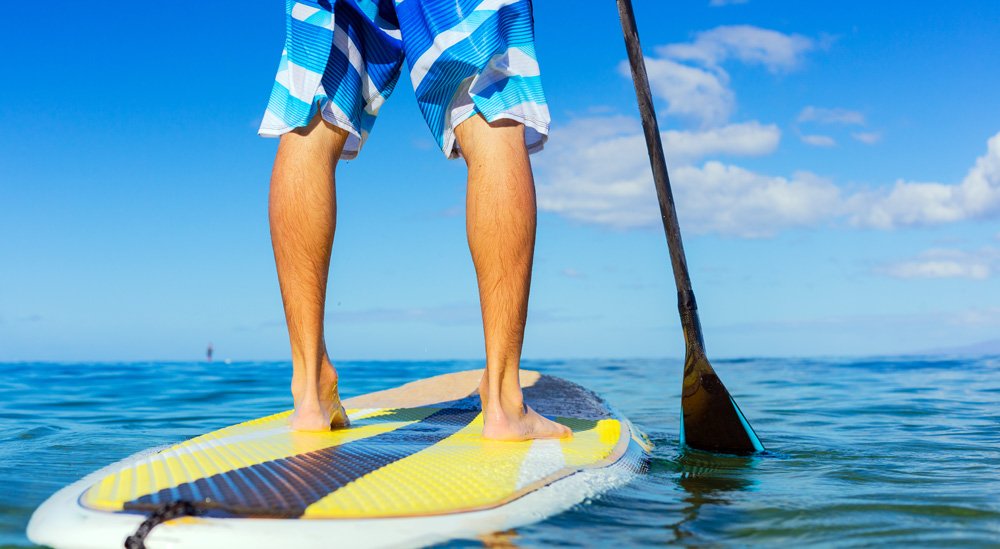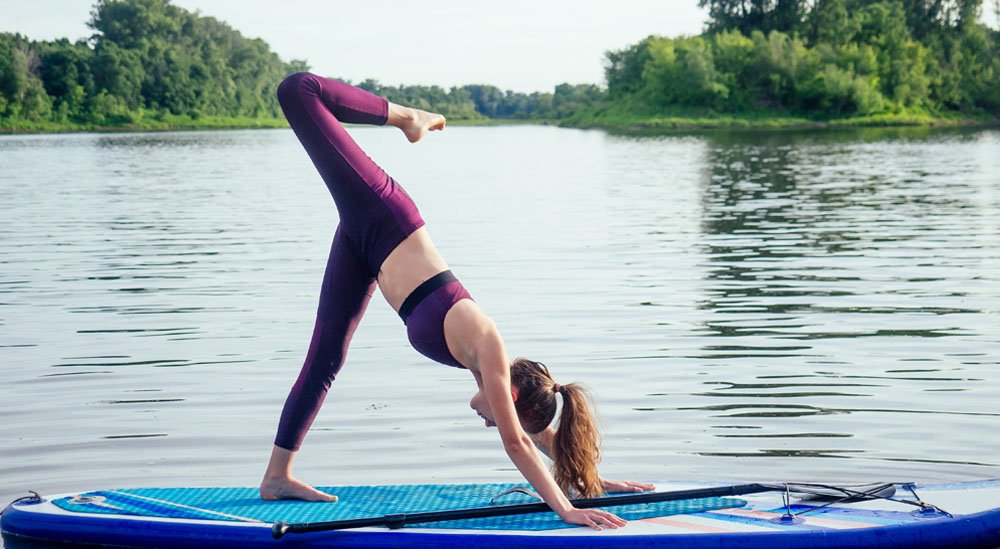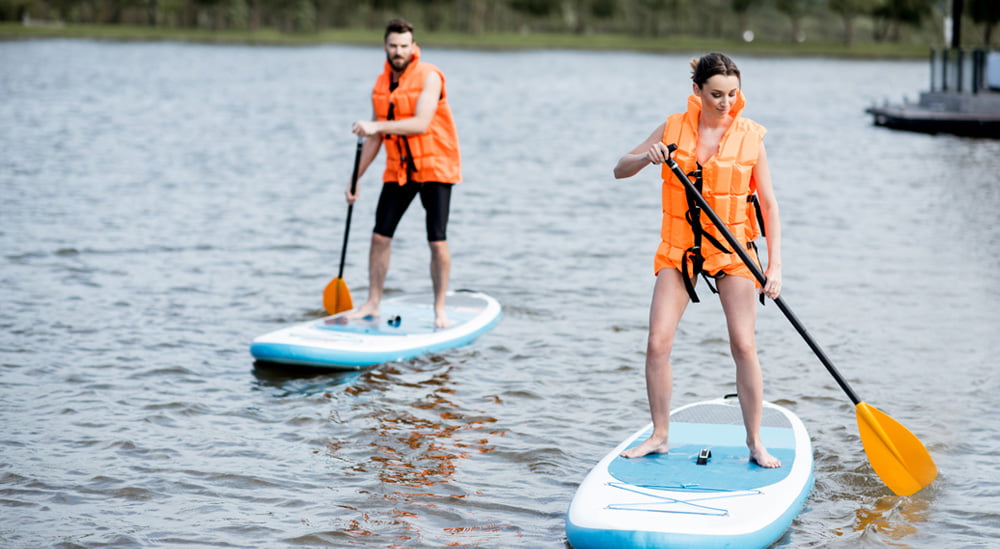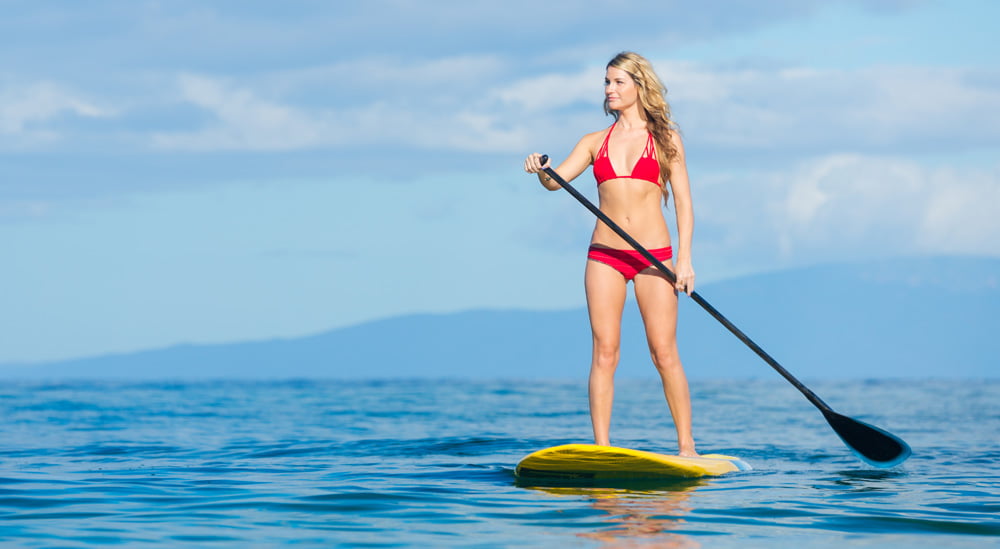Stand Up Paddle Boarding, commonly known as SUP, is a water sport that has been making waves in the fitness world. Originating from the surfing traditions of Hawaii, SUP involves standing on a large board and using a paddle to navigate across the water.
SUP is gaining popularity for a multitude of reasons. It’s a sport that combines the tranquility of being on the water with the benefits of a full-body workout. It’s accessible to people of all ages and fitness levels, and it can be as relaxing or as challenging as you want it to be.
From improving balance and strength to reducing stress and connecting with nature, the benefits of SUP are vast and varied. This article will delve into why Stand Up Paddle Boarding is the ultimate workout, exploring its physical and mental health benefits, its versatility, and how it compares to other sports. Whether you’re a seasoned athlete or a fitness newbie, SUP has something to offer you.
SUP is a Great Full-Body Workout
Stand Up Paddle Boarding is not just a fun water sport; it’s a comprehensive exercise that engages your entire body. From your core to your limbs, every muscle is put to work when you’re on a paddle board. Let’s explore how SUP targets different muscle groups:
Core Strength
One of the main benefits of SUP is the strengthening of the core muscles. The core is engaged throughout the entire SUP session, making it a fantastic workout for these muscles.
Balance plays a crucial role in SUP. Staying upright on a paddleboard requires constant adjustments and corrections, which are primarily driven by the core.
As you paddle, your body will naturally shift and sway to counteract the movement of the water. These subtle adjustments require a strong and engaged core, making SUP an excellent exercise for improving balance and core strength.
SUP is a fantastic workout for the core. By engaging these muscles throughout your SUP session, you can improve your balance, stability, and overall strength.
Arm, Shoulder, and Back Muscles
While Stand Up Paddle Boarding is a full-body workout, it particularly targets the arm, shoulder, and back muscles. Let’s explore this in more detail:
How paddling engages the arm, shoulder, and back muscles
When you paddle, you’re not just moving your arms. You’re using your entire upper body. This includes your biceps and triceps in your arms, your deltoids in your shoulders, and your latissimus dorsi and rhomboids in your back.
As you reach forward to place your paddle in the water, you’re using your biceps and deltoids. As you pull back, you’re engaging your triceps, latissimus dorsi, and rhomboids. This constant engagement of these muscles helps to strengthen them, improving your upper body strength and endurance.
Leg Muscles

While it may seem like Stand Up Paddle Boarding is primarily an upper body workout, it actually engages the entire body, including the legs. Here’s how:
The role of legs in SUP
Your legs play a crucial role in SUP. They act as stabilisers, keeping you balanced on the board. Every wave, every stroke of the paddle, every slight shift in the water – your legs are constantly adjusting to keep you upright.
When you paddle, your legs assist in the power transfer from your upper body to the paddle. This means that even though your arms and back are doing most of the work, your legs are also actively involved in the process.
How SUP strengthens leg muscles
Because your legs are constantly working to keep you balanced on the board, SUP provides a great workout for your leg muscles. This includes your quadriceps, hamstrings, calves, and even the small stabilizing muscles in your ankles and feet.
SUP can help improve your lower body strength and endurance, as well as your balance and coordination. This can have benefits in your daily life, making everyday activities easier and reducing the risk of falls and injuries.
Health Benefits of Stand Up Paddle Boarding
Stand Up Paddle Boarding is not just a fun outdoor activity; it’s also a fantastic way to improve your health and fitness. One of the key health benefits of SUP is its ability to burn calories. Let’s explore this in more detail:
Calorie Burning
One of the reasons why SUP is considered an excellent workout is due to its potential for high calorie burn. The number of calories you can burn during a SUP session can be quite impressive, making it a great choice for those looking to maintain a healthy weight or lose excess pounds.
How many calories does SUP burn compared to other sports?
The number of calories burned during SUP can vary greatly depending on several factors, but on average, you can expect to burn between 300-500 calories per hour during a casual paddle. This increases to 500-700 calories for more intense sessions, and up to 1000 calories for SUP racing.
When compared to other sports, SUP holds its own. For example, a casual bike ride burns around 300-400 calories per hour, while a moderate intensity swim burns around 400-600 calories. This makes SUP a competitive choice for calorie burning.
Factors that influence calorie burn in SUP
Several factors can influence how many calories you burn during a SUP session:
- Intensity: The harder and faster you paddle, the more calories you’ll burn.
- Duration: The longer your SUP session, the more calories you’ll burn.
- Conditions: Paddling in choppy water or against the wind requires more effort, leading to a higher calorie burn.
- Technique: Proper paddling technique can lead to a more effective workout and higher calorie burn.
- Body Composition: People with more muscle mass tend to burn more calories.
SUP is a versatile and effective way to burn calories, making it a great addition to any fitness routine.
Cardiovascular Health
Stand Up Paddle Boarding is not just a strength-building exercise; it’s also a fantastic cardiovascular workout. Regularly engaging in SUP can have significant benefits for your heart health.
How SUP improves cardiovascular health
SUP is an aerobic exercise, which means it gets your heart rate up and increases blood circulation. This has several benefits for your cardiovascular health:
- Improved Heart Health: Regular aerobic exercise like SUP can strengthen your heart, making it more efficient at pumping blood throughout your body.
- Lower Blood Pressure: Regular SUP sessions can help lower blood pressure levels, reducing the risk of hypertension.
- Reduced Risk of Heart Disease: Regular physical activity, including SUP, can reduce the risk of developing heart disease and stroke.
The role of endurance in SUP
Endurance plays a significant role in SUP. The longer you can paddle, the longer your heart rate stays elevated, leading to improved cardiovascular fitness.
Building endurance in SUP involves gradually increasing the duration of your paddling sessions. As your endurance improves, your heart becomes stronger and more efficient, leading to improved cardiovascular health.
Overall, SUP is an excellent workout for your heart. Not only does it help improve cardiovascular health, but it also helps build endurance, making it a great choice for a full-body workout.
Low Impact Exercise
One of the many advantages of Stand Up Paddle Boarding is that it’s a low impact exercise. This means that it’s gentle on your joints, making it a safe workout option for people of all fitness levels.
Why SUP is a safe workout option
SUP is performed on water, which naturally creates a soft and forgiving environment. Unlike high-impact exercises like running or jumping, SUP doesn’t put excessive stress on your joints. This makes it a safe workout option that carries a lower risk of injury.
Even though SUP is a full-body workout, the risk of strain or injury is significantly lower compared to other sports. This is because the movements in SUP are smooth and controlled, and the water provides a natural resistance that is gentle on the body.
How SUP is beneficial for people with injuries or joint issues
For people with existing injuries or joint issues, high-impact exercises can exacerbate their conditions. SUP, on the other hand, allows them to stay active without putting undue stress on their bodies.
SUP is particularly beneficial for people with knee or hip issues, as it strengthens the muscles around these joints without causing strain. It’s also a great option for people recovering from injuries, as it allows them to gradually regain strength and mobility.
Paddle Boarding is a versatile and inclusive sport that can be enjoyed by people of all fitness levels. Its low-impact nature makes it a safe and beneficial workout option for everyone, including those with injuries or joint issues.
Mental Health Benefits
While the physical benefits of Stand Up Paddle Boarding are well-documented, the mental health benefits are just as significant. Engaging in SUP can have a positive impact on your mental well-being.
The stress-reducing benefits of SUP
SUP is a great way to reduce stress and promote relaxation. The rhythmic nature of paddling can be meditative, helping to clear your mind and reduce feelings of stress and anxiety.
Paddle Boarding is a form of physical exercise, which is known to release endorphins, the body’s natural mood boosters. This can help to improve your mood and reduce feelings of stress and anxiety.
The role of nature and outdoor activities in mental health
Engaging in outdoor activities like SUP can have significant benefits for your mental health. Being in nature has been shown to reduce feelings of stress, anxiety, and depression.
The natural environment provides a sense of peace and tranquility that can be hard to find in urban settings. The sights, sounds, and smells of nature can have a calming effect, helping to improve mood and reduce stress.
Exposure to sunlight during outdoor activities like SUP can boost your vitamin D levels, which is linked to improved mood.
SUP is not just a physical workout; it’s also a mental health booster. The combination of physical exercise, connection with nature, and the meditative aspect of paddling makes SUP a great choice for improving mental well-being.
Versatility of Stand Up Paddle Boarding
One of the key advantages of Stand Up Paddle Boarding is its versatility. Whether you’re a beginner or an experienced athlete, SUP can be adapted to suit your fitness level and interests.

SUP for Different Fitness Levels
SUP is a highly adaptable sport that can cater to different fitness levels. For beginners, a gentle paddle on calm waters can provide a good introduction to the sport. As you gain confidence and strength, you can increase the intensity of your workouts by paddling faster, navigating rougher waters, or even trying SUP racing.
Paddle Boarding is not just about strength and endurance. It also involves balance and coordination, making it a well-rounded workout. This means that even if you’re not the strongest or the fastest, you can still enjoy SUP and reap its fitness benefits.
Different types of SUP activities
The versatility of SUP extends beyond the workout intensity. There are various types of SUP activities that cater to different interests:
- SUP Yoga: This involves performing yoga poses on a paddleboard. It’s a great way to improve balance and flexibility while enjoying the calming effects of being on the water.
- SUP Racing: For those who love competition, SUP racing can be a thrilling challenge. It involves paddling as fast as you can to beat other participants.
- SUP Touring: This involves long-distance paddling, often in scenic locations. It’s a great way to explore nature while getting a good workout.
The versatility of SUP makes it a great sport for people of all fitness levels and interests. Whether you’re looking for a gentle workout or an intense challenge, SUP has something to offer.
Stand Up Paddle Boarding vs. Other Sports
Stand Up Paddle Boarding is a unique sport that offers a variety of health benefits. But how does it compare to other sports in terms of calorie burn, muscle engagement, and overall health benefits? Let’s take a look:
Calorie Burn
As mentioned earlier, SUP can burn between 300 to over 1000 calories per hour depending on the intensity of the workout. This is comparable to other high-intensity sports like running or cycling. However, unlike these sports, SUP provides a full-body workout, engaging more muscle groups at once, which can lead to a higher overall calorie burn.
Muscle Engagement
One of the key advantages of SUP is that it provides a full-body workout. From your core to your limbs, every muscle is put to work when you’re on a paddleboard. This is in contrast to many other sports that focus on specific muscle groups. For example, cycling primarily targets the lower body, and swimming requires more upper body strength. SUP, on the other hand, engages all these muscle groups simultaneously, providing a well-rounded workout.
Health Benefits
In terms of health benefits, SUP holds its own against other sports. Like other forms of aerobic exercise, it improves cardiovascular health, helps maintain a healthy weight, and can boost mental well-being. However, SUP also offers additional benefits like improved balance and coordination, and it’s a low-impact exercise, making it suitable for people of all fitness levels and ages.
While each sport has its unique benefits, Stand Up Paddle Boarding stands out for its comprehensive full-body workout, its adaptability to different fitness levels, and its combination of physical and mental health benefits.
Getting Started with Stand Up Paddle Boarding
If you’re interested in trying Stand Up Paddle Boarding, there are a few things you’ll need to get started. One of the most important is choosing the right equipment.

Choosing the Right Equipment
Having the right equipment is crucial for a safe and enjoyable SUP experience. Here’s what you need to know:
How to choose the right paddle board
Choosing the right paddle board depends on your weight, skill level, and the type of paddling you plan to do. Here are some general guidelines:
- Size: In general, larger boards are more stable and easier to balance on, making them a good choice for beginners. Smaller boards are more maneuverable and faster, but require more skill to balance.
- Volume & Weight Capacity: The board’s volume and weight capacity should be suitable for your weight. If the board doesn’t have enough volume, it will sit too low in the water and be difficult to paddle.
- Type: There are different types of paddle boards for different activities. For example, touring boards are designed for long-distance paddling, while yoga boards are wider and more stable for performing yoga poses.
Other necessary equipment for SUP
In addition to a paddle board, you’ll also need:
- Paddle: SUP paddles are typically adjustable so you can set the length to suit your height. A general rule of thumb is to choose a paddle that’s 6 to 8 inches taller than you.
- Personal Flotation Device (PFD): Safety is paramount in any water sport. A PFD is a must-have for all paddlers.
- Leash: A SUP leash connects you to your board, preventing it from drifting away if you fall off.
- Protective Gear: Depending on the weather and water conditions, you might also need a wetsuit, water shoes, gloves, or a sun hat.
Choosing the right equipment is the first step to a safe and enjoyable SUP experience. Once you have your gear, you’re ready to hit the water!
Basic Techniques for Beginners
If you’re new to Stand Up Paddle Boarding, mastering a few basic techniques can help you get started. Here are some key techniques for beginners:
- Standing Up: Start by kneeling on the board, then slowly rise to a standing position, one foot at a time. Keep your feet shoulder-width apart, centered between the edges of the board.
- Paddling: Hold the paddle with one hand on the handle and the other hand halfway down the shaft. Paddle on one side of the board at a time, switching sides every few strokes.
- Turning: To turn, paddle on the opposite side of the direction you want to go. For sharper turns, paddle backwards on the side you want to turn towards.
- Balancing: Keep your knees slightly bent and your back straight. Look at the horizon, not your feet.
Safety Tips for SUP
Safety should always be your top priority when participating in any water sport. Here are some safety tips for SUP:
- Always Wear a PFD: A Personal Flotation Device (PFD) is a must-have safety item for all paddlers.
- Use a Leash: A SUP leash connects you to your board, preventing it from drifting away if you fall off.
- Check the Weather and Water Conditions: Before you head out, check the weather forecast and water conditions. Avoid paddling in strong winds, rough waters, or when a storm is expected.
- Know Your Limits: Don’t push yourself too hard, especially when you’re just starting out. Stick to calm, flat water until you’re confident in your skills.
Mastering the basic techniques and following safety guidelines are crucial for beginners in Stand Up Paddle Boarding. With practice and patience, you’ll be paddling with ease in no time.
Final Thoughts
Stand Up Paddle Boarding is more than just a fun water sport; it’s a full-body workout that offers numerous physical and mental health benefits. From improving your strength, balance, and coordination, to boosting your cardiovascular health, burning calories, and reducing stress, SUP truly is the ultimate workout.
SUP is a versatile and inclusive sport that can be enjoyed by people of all ages, body sizes, and fitness levels. Whether you’re looking for a gentle workout or an intense challenge, SUP has something to offer.
Choosing the right equipment and mastering the basic techniques are the first steps to a safe and enjoyable SUP experience. And with the variety of SUP activities available, from SUP yoga to racing and touring, you’re sure to find a style of SUP that suits your interests.
In conclusion, if you’re looking for a fun, versatile, and effective way to stay fit, why not give Stand Up Paddle Boarding a try? It’s a great way to enjoy the outdoors, stay active, and improve your health and well-being. So grab a paddle, hit the water, and experience the benefits of SUP for yourself!



